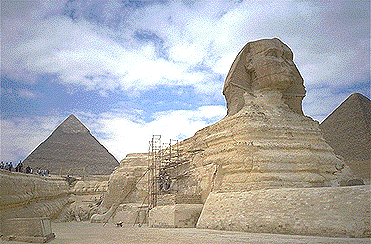Giza - Great Sphinx of Khafra

The Great Sphinx.
The Sphinx, with its monumental proportions, lion’s body, and human facial features, provides an unexpected naturalistic contrast to the geometric shapes of the pyramids. The recumbent lion stretches 241 feet/73.5 meters in length and reaches 65 feet/20 meters in height. The Sphinx was carved out of a natural outcropping of rock around the time of the construction of the Pyramid of Khafra [Chephren; c.2555-2532 B.C.E.] (to the left of the Sphinx). The features are thought to be those of King Khafra wearing the royal nemes headdress. The uraeus (rearing cobra) which originally sat on the king’s forehead is now lost, but fragments of his beard, which was added during the New Kingdom, are in the Cairo and British Museums.
The scaffolding is part of a project to preserve the Sphinx.

The Front View Showing the "Dream Stela" of Thutmose IV.
Between the front legs of the Sphinx and in front of his chest, is the "Dream" Stela of Thutmose IV (c.1400-1390 B.C.E.). This granite stela dates from the first year of Thutmose's reign and recounts a dream from his early years in which the Sphinx promised him kingship. In return, Thutmose would clear the sand from around the body of the Sphinx.
In front of the stela is a free-standing altar, a remnant of a chapel placed here during the reign of Ramesses II (c.1279-1213 B.C.E.).
Within this area, the legs of the Sphinx reach out to envelope the visitor, while the majestic head of the Sphinx dominates the space. The effect is quite awesome.
